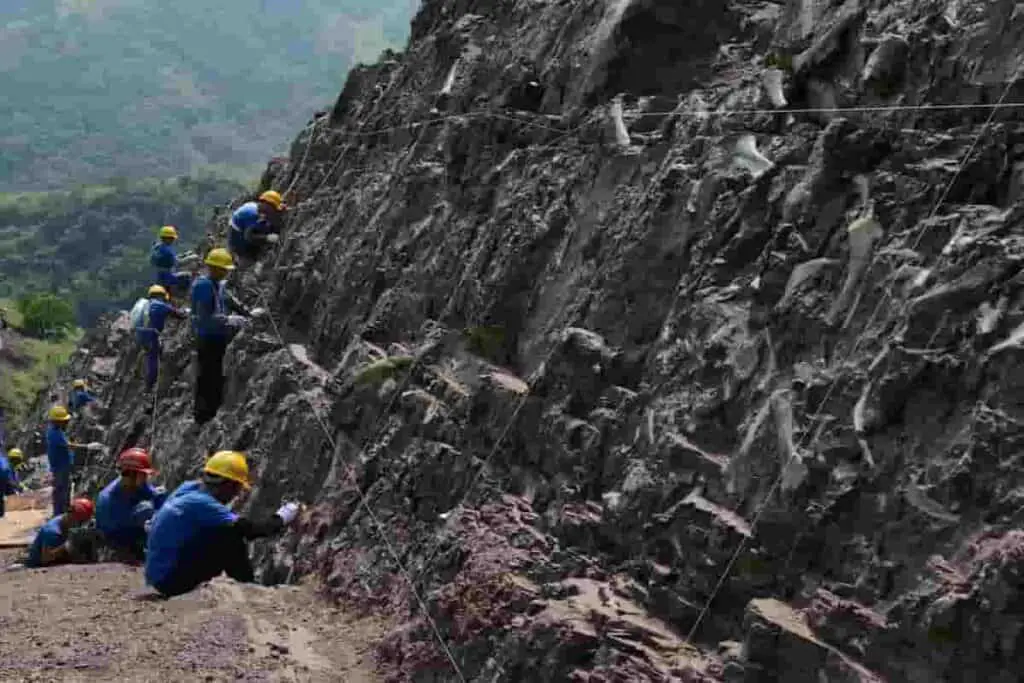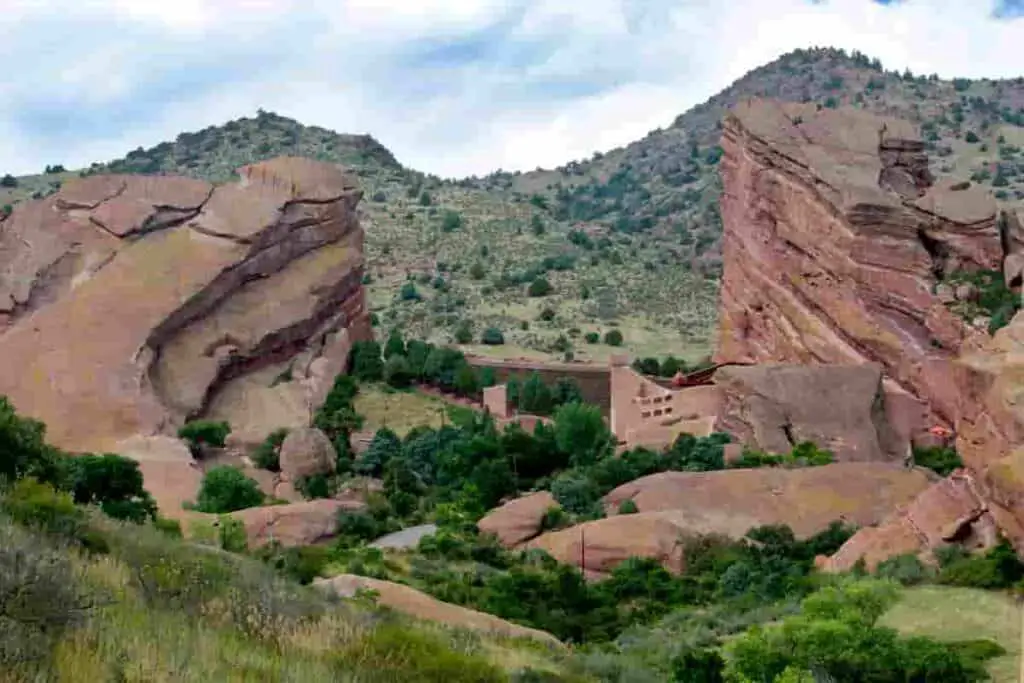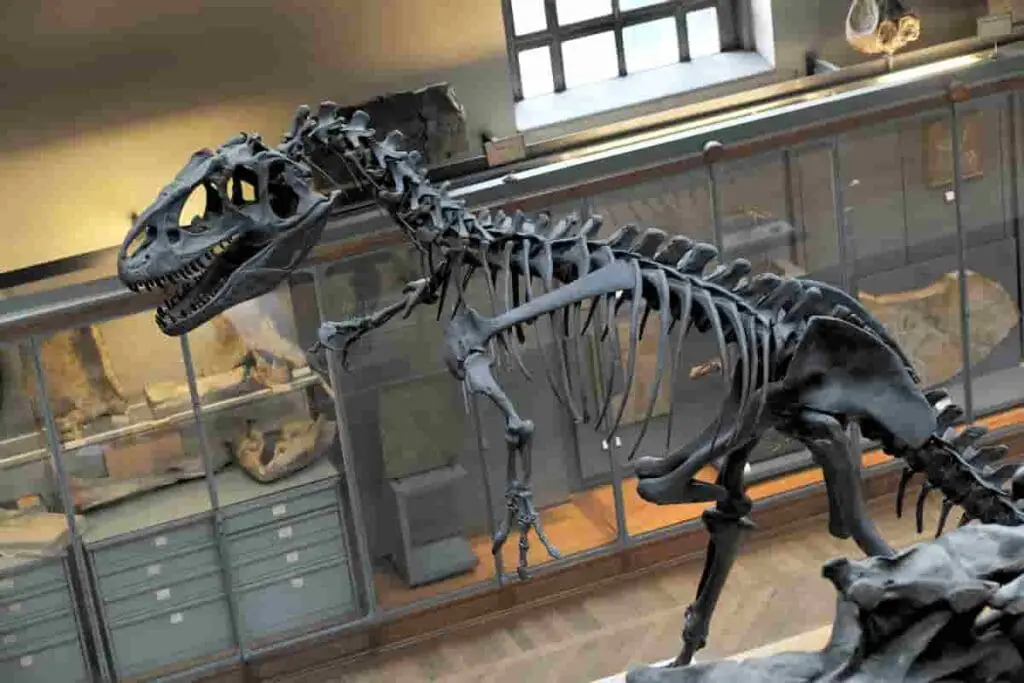Layer Rock Types Plus Deepest Dinosaur Fossils [World Record!]
Key Takeaways
- Dinosaur fossils often reside in sedimentary rocks, including mudrock and clastic formations, formed via cementation and chemical concentration.
- Paleontologists strategically evaluate the structure of rock layers before deciding whether to dig further in search of fossils.
- The deepest recorded dinosaur fossils were found 2,256 meters below the seabed, undisturbed for 200 million years.
- Dinosaur fossils become mineralized, preserving them within the rock formations over millions of years.
- Found dinosaur fossils can be privately owned, displayed, or even sold, depending on the discoverer’s preferences.
- Lending discovered fossils to paleontologists can further scientific knowledge about dinosaur species, benefiting dinosaur enthusiasts worldwide.
When paleontologists recover dinosaur fossils, it’s usually with tools such as a brush, a chisel, a knife, and a probe. You know that fossils aren’t usually an inch or two deep into the sediment, but precisely how deep are they?

How Deep Are Dinosaur Fossils Found?
So, how deep are dinosaur fossils found? Dinosaur fossils are found deep in the ground, sometimes several feet (or meters) below the surface. Paleontologists use various methods to locate and excavate these fossils, including digging through layers of sediment and rock. The depth at which dinosaur fossils are found can vary depending on factors such as the age of the fossil and the geological conditions of the area.
If you want to learn more about where dinosaur fossils are usually found in a rock formation and how deep are dinosaur bones found, this article is for you.
Paleontologists, the archaeologists of the prehistoric era, descend into the earth crust’s depth, unearthing dinosaur fossils from their ancient resting place – the rock strata beneath the surface. With each layer of strata signifying a different era of the geological time scale, the fossils relay a tale of prehistoric life, fluctuating species (dinosaur species especially), and evolution.
Surrounded by ancient sediment, these fossils offer insight into epochs like the Jurassic, Triassic, and Cretaceous. Known as the Mesozoic Era or the ‘Age of Dinosaurs’, these periods housed a myriad of dinosaur species, their frequencies varying with depth. An increase in depth typically correlates to a shift from the younger Cretaceous period to the much older Triassic period.
Table of Contents
Popular locations for these fossil sites encompass places like North America’s Hell Creek Formation or Asia’s Gobi Desert. These sites bear witness to the fossilization process that signifies organic material preservation in dinosaur remains, serving as a testament to life millions of years ago.
Unfortunately, carbon dating is ineffective due to the fossils’ antiquity, leaving paleontologists to rely on radiometric methods. Regardless of age-determining techniques, the fossils’ depth and local geological activities enlighten us about the species’ lifetime and prevalence. Hence, these intricate artifacts hidden beneath the surface of our planet are bytes of crucial information, unlocking many historical and biological secrets.
We’ll talk about rock layers and how paleontologists know whether a rock formation has any potential dinosaurs. We’ll even discuss if you could find dinosaur bones on your property and what to do if it ever happens.
Let’s get started!
What Layer of Rock Are Dinosaur Bones Found In?
The Mesozoic era, characterized by dinosaurs, left a legacy of fossils. These fossils, often embedded in sedimentary rock, narrate the tale of prehistoric biodiversity. Sedimentary rock, a subtype of clastic rock, is prevalently home to these aged remnants. The transformation of mineral particles into a clastic rock is a process that takes place in the Earth’s crust’s depths.
Fossil-collecting, a discipline involving the extraction and preservation of fossils, is intrinsically connected to regions containing mineral-rich sedimentary rock, such as areas abundant in clay. The Morrison Formation, a significant site for fossil hunting, is one such locality where sedimentary rock is found aplenty. The Morrison Formation, located in the western United States, is famous for hosting a wealth of dinosaur fossils, including those of Plateosaurus.
Hence, the discovery of dinosaur fossils unveils an epic voyage spanning millennia, housed in the depths of mineral-laden rocks like sedimentary and limestone, showcasing geology’s strategic role in introducing us to the Earth’s former inhabitants.
Suppose you ever get to visit such esteemed dinosaur fossil locations as the Morrison Formation in Colorado or any place like it. In that case, the layers of rock you’ll witness are multi-layered. That’s how these formations develop in the first place.
Plateosaurus, a herbivore from the late Triassic period, is one of the many dinosaur species unearthed from the Morrison Formation. The Morrison Formation also offers a peek into the crystallized remains of prehistoric life, with crystals being a form of mineral found in the fossils.
In addition to the clastic rock in the Morrison Formation, limestone, a different type of sedimentary rock composed of marine organisms, is another common fossil reservoir.
What will begin as one layer of rock becomes a second, then a third, and sometimes more.
Not all rock is the same. The three types of rock are metamorphic, sedimentary, and igneous. Let’s examine the three types now.
Metamorphic Rock
The first type of rock is known as metamorphic rock. These rocks undergo metamorphism, which changes the rock’s texture and mineral composition.
The rock that becomes metamorphic rock is originally a protolith, another word for a rock that has yet to undergo metamorphism.
When exposed to temperatures exceeding 300 degrees Fahrenheit and at high pressures, usually over 1,000 bar, the chemical and physical properties of the rock are altered. The rock will stay solid enough, but recrystallization will occur to an extent.

Sedimentary Rock
Next, there’s a sedimentary rock, which forms in a fascinating way.
The earth’s surface (or what at the time was the surface) will have organic particles or minerals deposited on it. Then, ions that travel through groundwater will reach the areas from one sedimentary grain to another and develop a crystalline material in texture.
A process that accomplishes this is called cementation. Through cementation, sediment grains are strengthened and bonded together. Hence, sedimentary rocks are formed.
Not all sedimentary rock is the same. Here is an overview of the various types.
- Chemical sedimentary rock: If the mineral constituents of sedimentary rock have a high chemical solution concentration, then chemical sedimentary rock can form. Gypsum, baryte, sylvite, and halite are examples of chemical sedimentary rock.
- Biochemical sedimentary rock: Organisms might grow tissue from materials dissolved in either water or air. For example, diatoms and radiolaria have a silicone skeleton that may leave chert deposits. These deposits are biochemical sedimentary rocks.
- Mudrocks: When sedimentary rock includes clay and silt particles at a rate of 50 percent or higher and the particles have a fine-quality grain, that’s mudrock. Mudrock occurs when air or water moves quickly, spreading the particles and causing them to move outside of their normal suspension.
- Classic sedimentary rock: Classic sedimentary rock formations form when clasts or rock fragments undergo cementation, as described above. The clasts may contain mica, clay minerals, feldspar, or quartz grains.
Dinosaur fossils are most likely found in sedimentary rock of the three rock layers.

Igneous Rock
Finally, there’s an igneous rock, often referred to as magmatic rock. When lava or magma settles on a surface, it doesn’t burn infinitely. Rather, the lava eventually cools and then becomes igneous rock.
Without igneous rock from oceanic crust to the extended crust, igneous provinces, basins, orogens, platforms, and shields, these geographic structures wouldn’t be possible.
World Record for Deepest Fossils Ever Found And Where Was It?
As far as the deepest dinosaur fossil ever found is concerned, Norway holds the record. At 2,256 meters below the seabed, the fossil was discovered during an oil drilling operation. Until now, no dinosaur fossil had been discovered this deep. An oil search made this fossil discovery possible. This fossil is a crushed knucklebone from a Plateosaurus that lived 210-195 million years ago in Europe and Greenland. (Source)
Tools That Paleontologists Use To Discover and Dig Dinosaur Fossils Out Of The Ground
Understanding tools that paleontologists rely on and their uses can provide valuable insight into the meticulous and often challenging work of paleontology.
The table below provides a concise overview of the essential tools used by paleontologists in their fieldwork. Each tool is listed with a brief description of its characteristics and its specific use in the process of fossil excavation and analysis. The tools range from high-tech devices like Ground Penetrating Radar to basic hand tools like chisels and rock hammers.
| Tool | Description | Use in Paleontology |
|---|---|---|
| Ground Penetrating Radar | A non-destructive method that uses radar pulses to image the subsurface. | Used to locate and map the presence of buried fossils without excavation. |
| Chisels | A tool with a characteristically shaped cutting edge for carving or cutting hard material. | Used to break away the stone around the fossils. |
| Walkie-talkie | A handheld, portable, two-way radio transceiver. | Used for communication in remote locations during digs. |
| GPS | Global Positioning System, a satellite-based radionavigation system. | Used to document every site with GPS coordinates in field notebooks. |
| Rock Hammer | A hammer used for breaking rocks. | Used to break rocks and extract fossils. |
| Probes | A device used to physically explore or examine something. | Used to move rock away from fossils. |
How Do You Know If a Rock Has a Fossil In It?
Paleontologists don’t simply dig up every layer of sedimentary rock, hoping to find dinosaur fossils. That could be massively destructive to structures and formations around the world.
Rather, paleontologists will use drones to survey landscapes that might be viable dinosaur fossil locations but are hard to reach. They can also determine if an area may have fossils through ground-penetrating radar.
Upon digging, the paleontologist will closely study the structure of the rock and decide if it’s worth evaluating and chiseling further.
Here are the criteria that’s used.
Test the Weight
Understanding now how sedimentary rock is formed, you can see how the structure of the rock changes over time, so too would the structure of a dinosaur fossil. Indeed, the fossil becomes mineralized.
Thus, a fossilized piece of rock will usually be heavier than a piece of rock of the same size and material that doesn’t contain a fossil.

Check the Surface
Where did the piece of rock come from that could contain a fossil? What does the rock’s surface look like relative to the nearby rock structure it came from?
If the rock’s surface is textured in any way, then that piece of rock may contain a fossil. Compare that to smoother rock, which is more than likely not a fossil. That’s regardless of the rock’s shape.
Color Inspection
The color of a piece of rock can also indicate whether it’s a fossil. A piece of rock with a lighter color is typically not a fossil, even if that rock feels heavier than other pieces of rock recovered from the same formation.
The only exception is if the rock happens to contain a noticeable fossil imprint, such as a limestone fossil shell.
Instead, darker colors are indicative of fossils, although not exclusively.
Pore Check
Finally, to confirm their suspicions of whether the rock may contain fossils, paleontologists will review the pores of the rock.
Like your skin has pores, rocks do as well. So too do bones have pores, although bone can also be dense depending on the type of bone in question.
A lack of pores could mean a paleontologist has found petrified wood, whereas the presence of pores might be a sign that it’s a porous fossil.
What Happens If You Find Dinosaur Bones on Your Property?
If you read our article on dinosaur fossil finds across the continents, you’ll recall that North America is frequently a popular spot for dinosaur fossils.
That’s not only in rock formations like Dinosaur Ridge, Petrified Forest National Park, or the abovementioned Morrison Formation.
In some instances, dinosaur fossils could be in your yard or elsewhere on your property. It does happen, especially due to soil erosion.

What if you find yourself in the unlikely but fortunate predicament of locating a dinosaur bone buried under your property?
Well, first, we would caution you to ascertain whether it’s truly a dinosaur bone. The methods mentioned above are a good place to start.
Once you’re positive you have a dinosaur fossil, what does that mean? Do you have to turn it over to the authorities? Your local museum?
No, you do not. Since your home is private property and the dinosaur fossils were found on that private property, the government cannot get involved. The government only deals in public property.
That means you can do whatever you want with the dinosaur fossils. If you want to keep them and display them around your house, you can. Should you want to sell them for a huge sum, that’s another option.
If you are indeed in possession of bonafide dinosaur bones, then you can expect quite a bidding frenzy. Dinosaur fossil collectors and professionals alike will be eager to see the bones. You could earn enough money to pay off your mortgage or put your child through college, maybe even both.
Our recommendation, should this predicament ever befall you? Keep the fossils if you must, but lend them to paleontologists or dinosaur experts for further study.
The fossil you found could be the only one of its kind. It could complete a skeleton for a dinosaur that still has a few missing parts, or perhaps the fossil is a discovery of a new species.
It’s nearly impossible to say for sure without experts studying the fossil. For the good of dinosaur fans everywhere, allowing professionals to assess the fossil can further the world’s knowledge of dinosaur species. That’s always worthwhile, we think.
Conclusion
Many dinosaur fossils that are unearthed come from sedimentary rock, one of three major rock types. In some rare instances, fossils have been buried deep under the seabed, where they may remain undisturbed over millions of years.
Sometimes finding fossils is far less complicated than that, as they could be in your backyard, especially if you live near a well-known rock formation!
Frequently Asked Questions
How deep are dinosaur fossils found?
Dinosaur fossils can be found at various depths depending on the location and geological conditions. Depending on the rock layers where the fossils are preserved, they can be found anywhere from a few meters to several kilometers deep.
What is the deepest dinosaur ever found?
The deepest dinosaur fossil ever found was discovered in Norway’s Snorre Offshore Field in the North Sea. This remarkable find was made during an oil drilling expedition, where paleontologists found the remains of a Plateosaurus at a depth of about 2,500 meters.
Who found the deepest dinosaur fossil in Norway?
The deep dinosaur fossil in Norway was found by paleontologists during an oil drilling exploration well at the Snorre Offshore Field in the North Sea. This surprising discovery was made by a team of scientists from the American Museum of Natural History and other institutions.
How deep was the well at the Snorre Offshore Field where the deepest dinosaur fossil was found?
The well at the Snorre Offshore Field, where the deepest dinosaur fossil was found, was drilled to a depth of about 2,500 meters. Scientists utilized a long cylinder of rock drilled from the seabed to retrieve the fossilized remains.
How old is the deepest dinosaur fossil ever found?
The deepest dinosaur fossil ever found in Norway is estimated to be from the early Jurassic period, dating back approximately 210 to 195 million years.
How does a dinosaur fossilize?
Dinosaur fossils are formed when the remains of a dinosaur are buried by sediment, such as mud or sand, over long periods of time. As these layers of sediment build up, they gradually harden into rock, preserving the bones and other organic matter of the dinosaur as fossils.
Why is the discovery of the deepest dinosaur fossil in Norway significant?
The discovery of the deepest dinosaur fossil in Norway is significant as it sets a new world record for the deepest dinosaur ever found. This finding provides valuable insights into the paleontological history of the region and contributes to our understanding of dinosaur evolution.
What specific dinosaur was found at the Snorre Offshore Field?
At the Snorre Offshore Field, paleontologists found the remains of a Plateosaurus, which is an herbivorous dinosaur from the Triassic period. This dinosaur is characterized by its long neck and tail, and it could weigh up to four tons.
How long and how much does the deepest dinosaur fossil ever found weigh?
The deepest dinosaur fossil ever found in Norway, belonging to a Plateosaurus, was estimated to be about 2 meters long and weigh up to four tons.
Why are paleontologists interested in exploring rock layers to find dinosaur fossils?
Paleontologists look for dinosaur fossils in rock layers because these layers provide a record of past environments and the organisms that lived during different geological periods. By studying these fossils, scientists can gain insights into the evolution and diversity of dinosaurs and their ecosystems.
